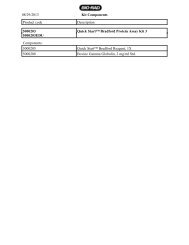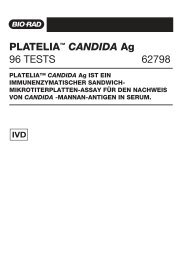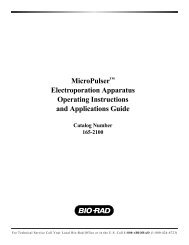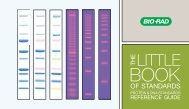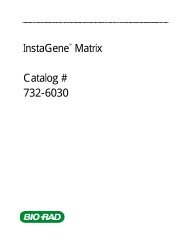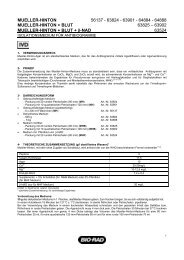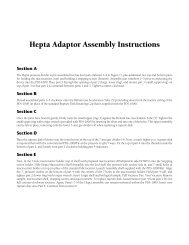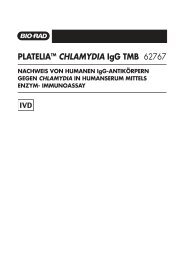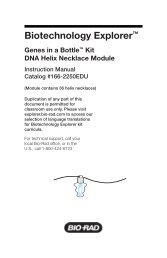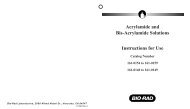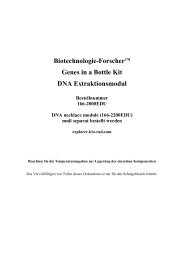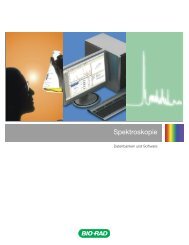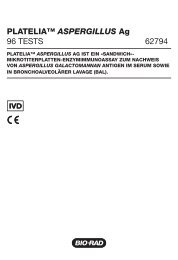Protein Expression and Purification Series - Bio-Rad
Protein Expression and Purification Series - Bio-Rad
Protein Expression and Purification Series - Bio-Rad
Create successful ePaper yourself
Turn your PDF publications into a flip-book with our unique Google optimized e-Paper software.
<strong>Protein</strong> <strong>Expression</strong> <strong>and</strong> <strong>Purification</strong> <strong>Series</strong><br />
Chapter 4: Culturing, <strong>Expression</strong>, Lysis <strong>and</strong> SDS-PAGE<br />
Analysis for 11 ml Cultures for Centrifugation <strong>Purification</strong><br />
Process<br />
Cell Culture <strong>and</strong> Induction<br />
Student Workstations<br />
Each student team requires the following items to streak a starter plate to produce single bacterial colonies:<br />
Material Needed for Each Workstation Quantity<br />
LB/amp plate 1<br />
Sterile inoculating loop 1<br />
2–20 µl adjustable-volume micropipet <strong>and</strong> tips 1<br />
Marking pen 1<br />
Common Workstation Quantity<br />
Rehydrated BL21(DE3) E. coli containing pDHFR 1<br />
Incubator set to 37°C 1<br />
Each lab team will streak their own starter plate as a source of cells for culture for protein production.<br />
LB/amp plates should be streaked for single colonies <strong>and</strong> incubated at 37°C for 16–24 hours before the<br />
initial culture activity is planned.<br />
Student Protocol: Streaking starter plates to produce single bacterial colonies<br />
on agar plates<br />
Using the rehydrated BL21(DE3) E. coli containing pDHFR at the Common Workstation to streak<br />
one plate. The purpose of streaking is to generate single colonies from a concentrated suspension of<br />
bacteria. A minute amount of the bacterial suspension goes a long way. Under favorable conditions,<br />
one cell multiplies to become millions of genetically identical cells in just 24 hours. There are millions of<br />
individual bacteria in a single 1 mm bacterial colony.<br />
1. Pipet 10 µl of reconstituted E. coli using a sterile pipet tip onto an LB/amp plate. Use a sterile loop to<br />
perform the streaking. Streaking takes place sequentially in four quadrants. The first streak is to just<br />
spread the cells out a little. Go back <strong>and</strong> forth with the loop about a dozen times in one quadrant as<br />
shown in Figure 4.1a. In subsequent quadrants the cells become more <strong>and</strong> more dilute, increasing the<br />
likelihood of producing single colonies.<br />
2.<br />
For subsequent streaks, the goal is to use as much of the surface area of the plate as possible. Rotate<br />
the plate approximately 45 degrees (so that the streaking motion is comfortable for your h<strong>and</strong>) <strong>and</strong><br />
start the second streak. Do not dip into the rehydrated bacteria a second time. Go into the previous<br />
streak about two times <strong>and</strong> then back <strong>and</strong> forth as shown in Figure 4.1b for a total of about 10 times.<br />
3. Rotate the plate again <strong>and</strong> repeat streaking (Figure 4.1c).<br />
Rotate the plate for the final time <strong>and</strong> make the final streak (Figure<br />
4. 4.1d). When you are finished<br />
streaking the plate, cover it immediately to avoid contamination. Label the plate with your initials.<br />
Chapter 4: 11 ml Culture Protocol for<br />
Centrifugation <strong>Purification</strong><br />
91<br />
CHAPTER 4<br />
11 ml CULTURE<br />
PROTOCOL



